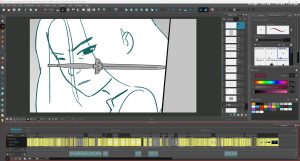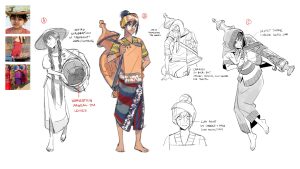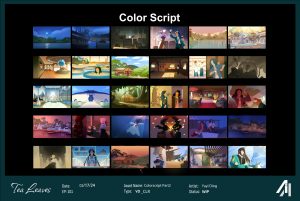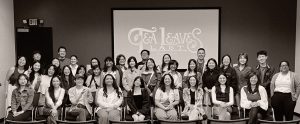

In Tea Leaves Last, Mya leaves her homeland on a quest to discover the forgotten secrets of tea magic in order to save her family’s farm. In search of her hereditary tea farm, she finds herself in Ci, a sprawling city not unlike Singapore. Once she discovers a colonizing force that threatens to destroy her heritage, Mya’s pursuit of magic and allies becomes more imperative than ever.
Inspired by magical girl series like Sailor Moon and Winx Club, Tea Leaves Last explores the deep history of tea in Asia. It takes direct inspiration from multiple Asian cultures and military conflicts to explore themes of cultural identity, colonialism, and friendship.
The 44-minute pilot animatic for Tea Leaves Last was produced through Asians in Animation’s TV pre-production program and spearheaded by executive producer and showrunner Saira Umar. We had an opportunity to discuss the inspirations behind the ambitious project with Saira as well as her experience leading preproduction in Storyboard Pro.
Saira: I'm Saira Umar. I was the creator, showrunner and executive producer of Tea Leaves Last. My day job currently is a production assistant at Marvel. Before that I was a production assistant working at Titmouse. I volunteer with Asians in Animation, which is a nonprofit organization.
This was their first foray into longer form creation. The organization wants to start getting more into producing their own things. And being a place for creatives, especially underrepresented creatives, to express themselves where we might not be able to traditionally.
I’ve been working with them for the past almost five years. When this next step came up last September, I was really interested in taking it since that's my career goal — to be a showrunner at a studio.

Thumbnails from Tea Leaves Last by storyboard artist Xena Seo.
Saira: When they wanted to do longer form, I wanted to do TV specifically because that's what I work in, and what I'm passionate about. I have written a lot of pilots. And I had confidence that we could make a pilot since I know how that schedule works.
At the start, they asked, “Do you want to work on a script that you already have?” But I didn't necessarily want to do that for this first run of a volunteer program, because then it might feel like everyone's just making my idea rather than feeling like they helped shape it from the start.
I also wanted to get the developmental writer's room experience with AiA’s Writers’ Group, which I've been meeting with for three years now. We've all become friends. I thought it'd be really cool if all of us got this experience to do a writer's room together and develop an idea from scratch. I gave them a wish list of things that I like in stories: history, fantasy, themes of culture, food, and then we got pitches from the writer's room.
My story editor and co-writer, Stephanie Sim, ended up pitching this idea like “Bridgerton meets Sailor Moon,” which was for a little bit of a younger-aged demographic. Everyone was really excited about the.core concept of magic tea powers.
Since I personally love telling stories for a slightly older audience, with a little bit more complexity, I said, “This is a great start. Let's age it up. Let's add real history, nuance and themes about politics and colonialism.” And we went from there.

Screenshot of a scene from Tea Leaves Last in Storyboard Pro. Panel drawn by Vanessa To.
Saira: It was a bit of a coincidence. We did start from being inspired from the magical girl genre, but I wanted to make sure we were inclusive of all genders. So our magical team will eventually include guys as well. And our main character, Mya, is non-conforming to gender, or doesn't really adhere to gender in the same way that western society does.
In my other personal work, I often tell stories with a lot of women. The first time I wrote a script with a male main character, I realized how female-forward my work generally tends to be. Also with AiA in general as an organization – of course, we're inclusive to everybody, but a lot of the leadership happens to be female or queer people, even though we try to bring everyone in.
Saira: Yeah. The initial pitch was more Regency time period. And of course, I love that aesthetic and stories about old Europe, Princesses, and all that stuff. But we are Asians in Animation and we also want to find a way to make more Asian representation on screen.
When you think of tea, the two main cultures are British and Chinese. I was looking a lot into the history of tea itself and how it's so tied with colonialism. Even in America – the Boston Tea Party, the Opium Wars – all of it is related to tea. I also was looking at my own history and the origin of tea was in a place between Burma and China. And I am Burmese and Chinese. So that is very specific to me. And Burma is a country that is not very much talked about, it's more unknown.
We were trying to think of how to match tea powers to [each character]. There are seven official types of tea: white tea, black tea, green tea, and so on. I looked at which cultures have a significant drink made with those teas. So we went from there. And each country has a house. The house in Ci, which is Chinese-inspired, is Gongfu Cha. That's Wen Yi's. Chai is the South Asian, Pakistani tea, which is Jai's, another culture that I share roots with.
They each have their own tea house, which is kind of like their tea flavor or type, basically. Then their powers are more linked to their personality. And it's just activated by the tea.

Character exploration of Mya, drawn by visdev artist Vy-Anh Nguyen.
Saira: I think the highlight is, of course, getting to meet so many new people with so much potential. And it's just so rewarding to see people grow, see people create. Seeing new art come in is like opening a present. And it's always something beautiful.
I think one challenge was the logistics. It was all volunteer, all remote, and all-hours, basically. I would be getting messages at five in the morning from East coasters all the way until two in the next morning because we have people in Europe and in Asia. With myself based in Los Angeles being the leader, I felt a big responsibility to respond to people. Because if I didn't right away, it would be holding them up.
Saira: One thing that AiA has been working on is making sure that [our projects are] accessible. But the software was kind of a barrier of entry. We hired people that had Storyboard Pro already because we knew that's what we were working out of, and that is industry standard. So everyone who applied pretty much had it and had experience using it.
I had an interesting experience myself with Storyboard Pro because I learned it for the first time. In my day job in production, I use it just to export boards and take care of the formatting and admin side of Storyboard Pro. On Tea Leaves Last, I taught myself Storyboard Pro to actually use it as an artist to help out the team with thumbs, acting, and cleaning up boards. I definitely saw myself getting more and more used to it and getting better at it as I went, learning all the shortcuts and stuff.

Color script for the Tea Leaves Last pilot, designed by Yayi Ding.
Saira: We were pretty surprised by the views, given that we didn't do much marketing in advance. AiA didn't have too many YouTube subscribers before this, less than 1,000. (Which has now doubled to 2k at the time of publishing). So when we reached the first 5k, 10k, 15k views, I was really excited. Like, “Wow, that many people actually watched this thing that we poured so much time and love into!”
I hope this inspires people to make their own projects like this. And I want to shout out to the whole crew. They were all very dedicated, passionate, talented people that definitely should be working in the industry.

Photo of the crew from an in-person screening at Titmouse's studio in Burbank.
The post Saira Umar on Asians in Animation's pilot animatic, Tea Leaves Last appeared first on Toon Boom.